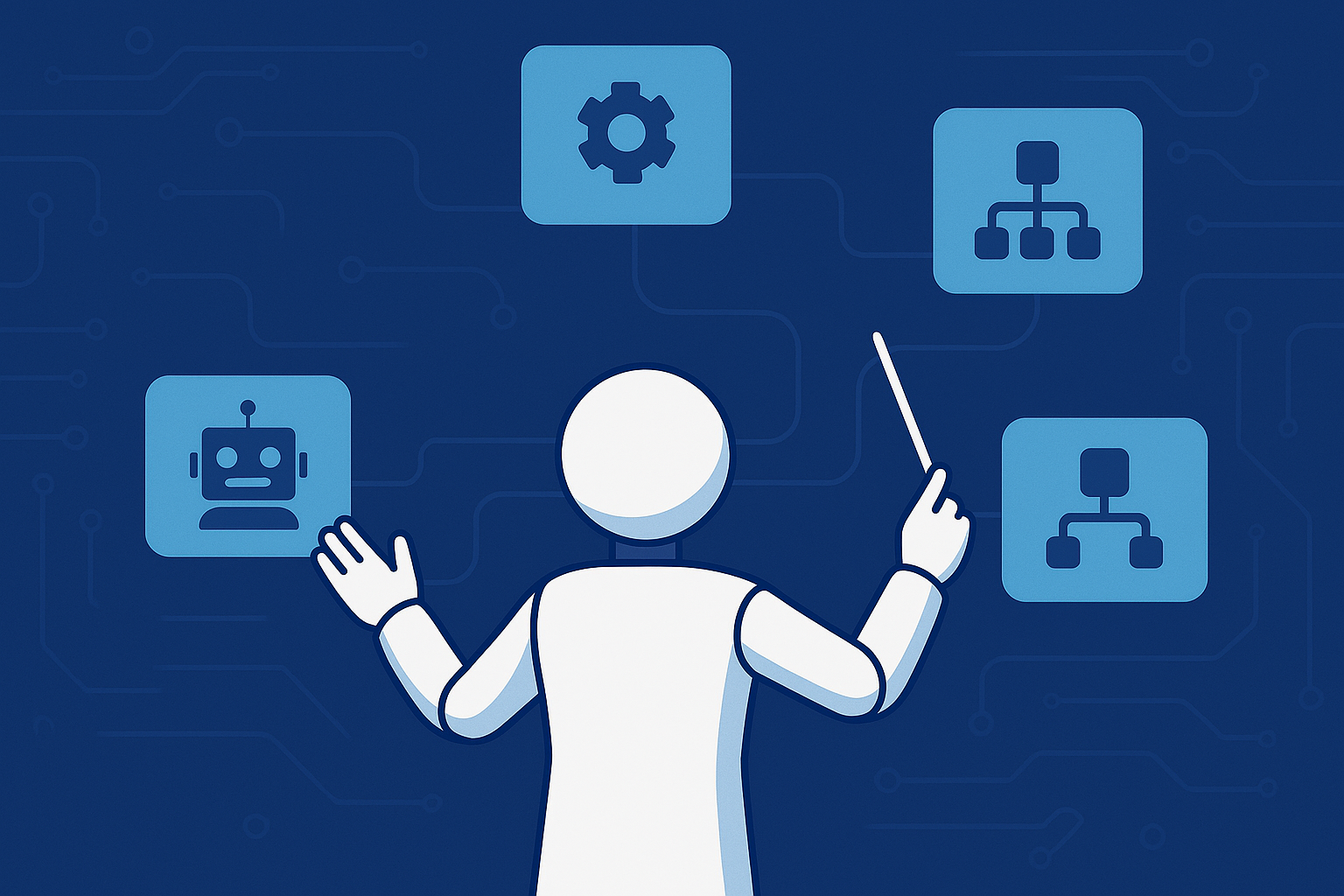In the first wave of enterprise AI, copilots stole the spotlight. These helpful assistants — embedded into tools like Microsoft 365, Google Workspace, and Salesforce — made AI feel accessible, augmenting human productivity with suggestion engines and chat-based interactions. But in 2025, it’s increasingly clear that copilots are not the final destination and often bare the stench of “not good enough”.
Enter AI agent orchestration platform: a new concept to many, and increasingly critical to a growing minority of leaders, it’s a strategic layer that coordinates fleets of autonomous agents, each with specialized capabilities, across workflows, tools, data and teams. If copilots were the AI equivalent of an AI intern, orchestration platforms are shaping up to be the conductor of enterprise AI ecosystems — and they’re quickly becoming the next battleground for differentiation among major platforms.
“When we say ‘AI-first,’ we don’t just mean using AI to make things more efficient — we mean reorganizing around it. That includes designing systems where agents can act, learn, and collaborate on their own,” says Robb Wilson, CEO and Co-Founder of OneReach.ai, and co-author of the bestselling book, Age of Invisible Machines.
From Copilots to Orchestration Platforms: A Structural Shift
The early adoption of copilots proved there’s real appetite for AI-enhanced productivity. But these tools are too often siloed, reactive, and bounded by the app they live in. They don’t access data, people or agents across systems, handle multi-step objectives, and r manage or collaborate with other agents. That’s where orchestration platforms come in.
An AI orchestration platform is a runtime architecture — often sitting between the interface and foundational models — that can:
- Break down goals into subtasks
- Assign those tasks to specialized agents
- Coordinate data, memory, and progress across time and tools
- Adapt workflows based on context, outcomes, or new instructions
In other words, orchestration platforms transform isolated AI actions into coordinated operations — a shift that redefines both UX and enterprise architecture, and in many ways, the common enterprise. .
Why Orchestration Matters Now
This shift is more than a technical upgrade — it’s a strategic inflection point. A few converging forces explain why orchestration is trending now:
- Agent maturity: Agents are no longer one-off hacks or demos. Platforms like OneReach.ai have demonstrated how networks of agents, overseen by a meta-agent, can drive real business outcomes at scale.
- Enterprise appetite for autonomy: As organizations automate knowledge work, they need more than reactive assistants — they need systems that proactively complete tasks, learn over time, and that uphold effective human in the loop practices.
- Vendor momentum: Microsoft’s Build 2025 keynote emphasized “open, agentic systems.” Salesforce launched its own acknowledgement of the need for an orchestration layer (“Agentforce”), and others — from Slack to SAP — are racing to follow early movers like OneReach.ai, which were building for this moment when few others were even thinking of it. , It’s reminiscent of NVIDIA’s bold investment in AI chips over a decade ago, which is now paying off massively.
- AI-first architectures: Orchestration is central to any AI-first philosophy, which reimagines software around agents, goals, and natural language rather than UI forms and APIs.
Designing for Orchestration
The rise of orchestration platforms for tools also redefines what it means to design for AI. Instead of a single touchpoint, designers must now map goal-based journeys that span multiple tools and surface contexts. Some key UX shifts to consider:
- Interaction becomes episodic: Users may start a task in Slack, but it’s completed hours later by agents across Salesforce, email, or internal dashboards. The UX must account for asynchronous updates and transparent handoffs.
- Explainability by design: Orchestrated systems can feel like black boxes. Clear signals — what the agent is doing, what it knows, what it needs — are crucial for trust.
- Control without micromanagement: Users need to guide orchestration without drowning in prompts. Designers must surface meaningful checkpoints, following best practices for human-in-the-loop levers and controls, not constant questions.
- Orchestration-Platrform-as-interface: In some cases, the orchestrator is the product, or the facilitator of the product. How users communicate goals, review progress, and override decisions becomes the core design challenge.
What This Means for Product Teams
If you’re a product owner, architect, or design lead inside a large organization, now is the time to explore:
- Do we need an orchestration layer? Yes. Whether your AI assistants are hitting limits or not, orchestration will unlock broader impact and is required for remaining competitive
- Are we building or buying? Some firms are developing their own orchestration runtimes; others are turning to platforms like OneReach.ai or Microsoft’s Copilot Studio.
- How will we govern autonomous behavior? Orchestration brings power — but also the need for oversight, simulation, and ethical boundaries.
- What workflows could agents own end-to-end? Map your internal processes to find low-risk, high-leverage orchestration opportunities. Start simple and small, and start internally facing. Or as Robb Wilson and Josh Tyson put it in their bestselling book about successfully orchestrating AI agents:
“The easiest way to get started is often to automate internally first; start small by automating individual tasks and skills, not entire jobs. Some of these early automations might seem underwhelming, but the simpler you make your starting point, the sooner you can test and iterate. The sooner you test and iterate, the sooner you can roll out an internal solution. You’ll continue testing and iterating on that solution, using the momentum to find new skills to develop, test, iterate on, and deliver. You’ll fumble often as you grow legs, but that’s part of the process, too. In the realm of hyperautomation, we are more agile than Agile (hyperagile, in a sense). With the right tools and budding ecosystem, the iteration process becomes so speedy that failures are often quick rewards that point to better solutions. Because fixes and new solutions can be tested and deployed quickly and at will, your organization can build on wins and gain speed.”
Final Thoughts
Copilots helped enterprises dip their toes into AI. But orchestration platforms and toolss are where the real transformation begins — systems that can understand intent, break it down, distribute it, and deliver results with minimal hand-holding.
This is not just a new layer of technology — it’s a new way of thinking about how software gets things done.
As AI agents mature, orchestrators will define how work flows, how teams scale, and how enterprise architecture and UX is built. The post-copilot era has arrived. Welcome to orchestration nation.
Sources & References
- Microsoft 365 Copilot
https://www.microsoft.com/en-us/microsoft-copilot - Google Workspace AI Features
https://workspace.google.com/blog/product-announcements/generative-ai-google-workspace - Salesforce Einstein Copilot
https://www.salesforce.com/products/einstein/copilot/ - Robb Wilson on LinkedIn
https://www.linkedin.com/in/robbwilson/ - OneReach.ai – AI Orchestration Platform
https://onereach.ai/ - Age of Invisible Machines (Book by Robb Wilson and Josh Tyson)
https://www.amazon.com/Age-Invisible-Machines-Authoritative-Conversational/dp/1544535895/ - Microsoft Build 2025 (Newsroom)
https://news.microsoft.com/build/ - Salesforce Agentforce Announcement
https://www.salesforce.com/news/stories/agentforce/ - NVIDIA’s Early Investment in AI Chips
https://www.wsj.com/tech/ai/nvidia-ceo-jensen-huang-gpu-investment-61a23b52 - AI First Foundation – AI-First Architecture Philosophy
https://www.aifirstprinciples.org/ - Microsoft Copilot Studio Overview
https://techcommunity.microsoft.com/t5/microsoft-copilot-blog/introducing-copilot-studio-build-custom-copilots-with-generative/ba-p/3987203








